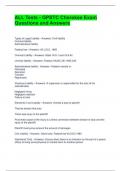Exam (elaborations)
pearson stats questions Qustions & Answers Correct!!!!
- Course
- Institution
-2 log likelihood (ratio) test - ANSWERUsed in logistic regression, it is a form of chi-square test which compares the goodness of fit of two models where one model is a part of (i.e. nested or a subset of) the other model. The chi-square is the difference in the -2 log likelihood values for the tw...
[Show more]












